
Composable Architecture as the Right Development Scenario for E-Commerce
Over the last couple of years, the composable digital experience platform (DXP) has become an alternative to traditional monolithic platforms, which technology experts recommend decomposing in order to meet changing market needs. A composable DXP allows an application architecture to be built from separate modules—also called business capabilities, or microservices—and use the best-of-breed modules to get the most out of an e-commerce platform for as long as possible.
According to Gartner, by 2023, organizations that have adopted an intelligent composable approach will outpace the competition by 80% in the speed of new feature implementation.1 By 2027, 60% of organizations will adopt composable thinking in their customer experience strategy, enabling cross-functional teams to respond to changing customer needs.2
Gartner’s insights have shown that a composable DXP is the preferred way to deliver digital user experiences and future-proof a technology stack.
The Most Popular Ways to Organize Digital Commerce Platforms
Gartner highlights three popular approaches to creating digital commerce architecture:
- Commerce-led—a holistic platform provided by a single vendor where a storefront is closely coupled to a commerce engine and APIs are used for side purposes only
- Experience-led—a platform with a user-centered interface where a storefront is connected to a commerce engine via APIs
- Modular, or API-first—a platform deployed from independent composable parts that are connected to a storefront via APIs
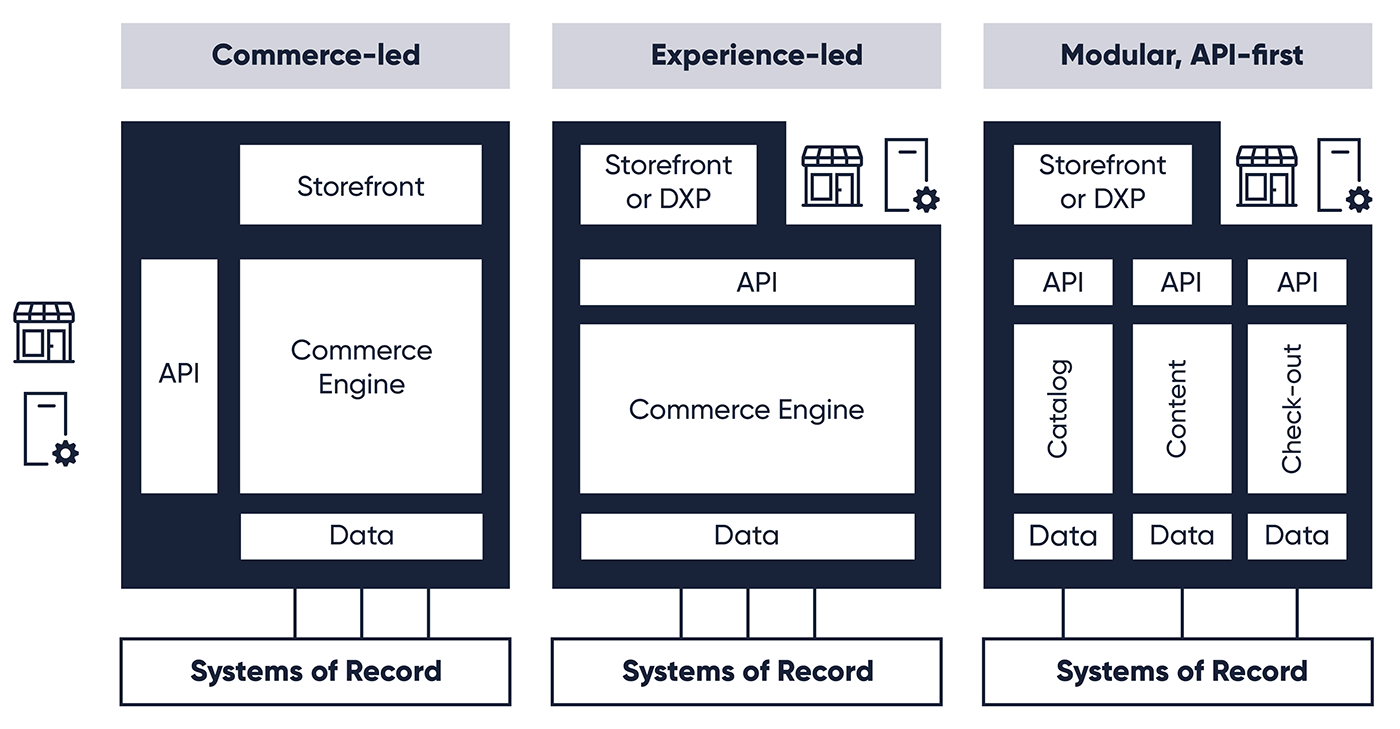
Image 1.
Source: Gartner, Inc., “Choose the Right Digital Commerce Platform Architecture” by Aditya Vasudevan and Mike Lowndes, published 29 April 2021, Gartner®
While commerce-led architecture suggests that a platform may provide a variety of core features, it also imposes limitations on involving additional modules, platform scalability, and extensibility. Such platforms don’t adhere to the composable approach. With experience-led and modular architectures, a commerce engine can incorporate several granular APIs to add new modules and extend a platform to support business needs. Though it takes longer and costs more to deliver API-centric platforms, they provide a wide range of opportunities for extending a business model and managing customer experience.
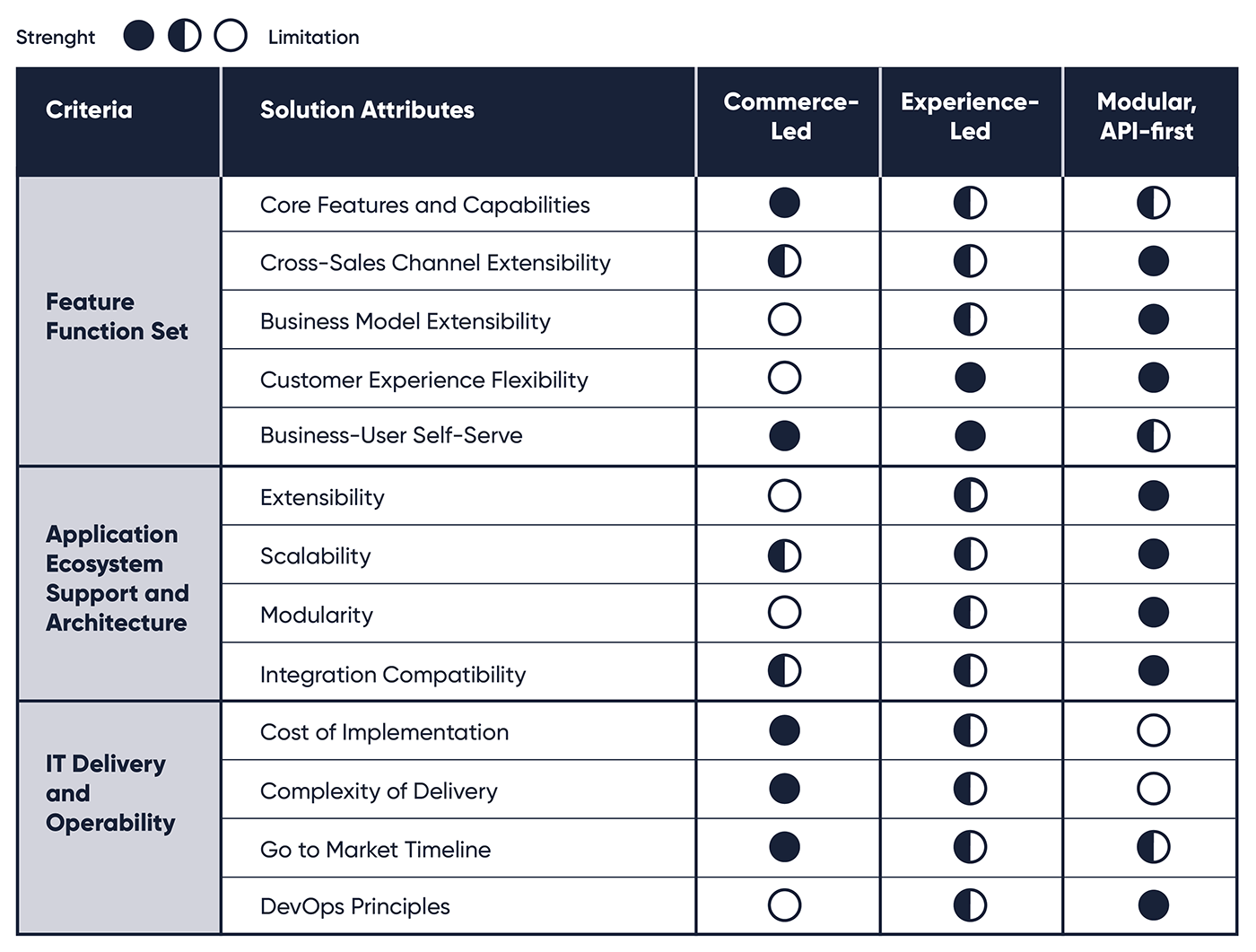
Image 2.
Source: Gartner, Inc., “Choose the Right Digital Commerce Platform Architecture” by Aditya Vasudevan and Mike Lowndes, published 29 April 2021, Gartner®
In general, Gartner recommends organizations choose a digital commerce architecture based on key business objectives, and certain organizations may decide to concentrate on the commerce-led approach. However, the trend is for digital commerce to go beyond the catalog experience by shifting to a more flexible, componentized architecture and API orientation. Commerce functions packaged as discrete APIs, including those built on microservices, are emerging rapidly.
MACH Principles to Deliver Innovation Faster
MACH Enables Composable DXPs
MACH architecture allows us to create composable DXPs. Separate business modules—such as content, catalog, and search—can be built in accordance with the MACH principles and delivered through APIs. Composable architecture revolves around MACH-certified modules and involves using APIs for mediation. The modules can also be interconnected by middleware, integration events, and jobs. To manage the user’s experience of the entire solution, the presentation must be orchestrated by a DXP to bring together disparate parts of the user experience.
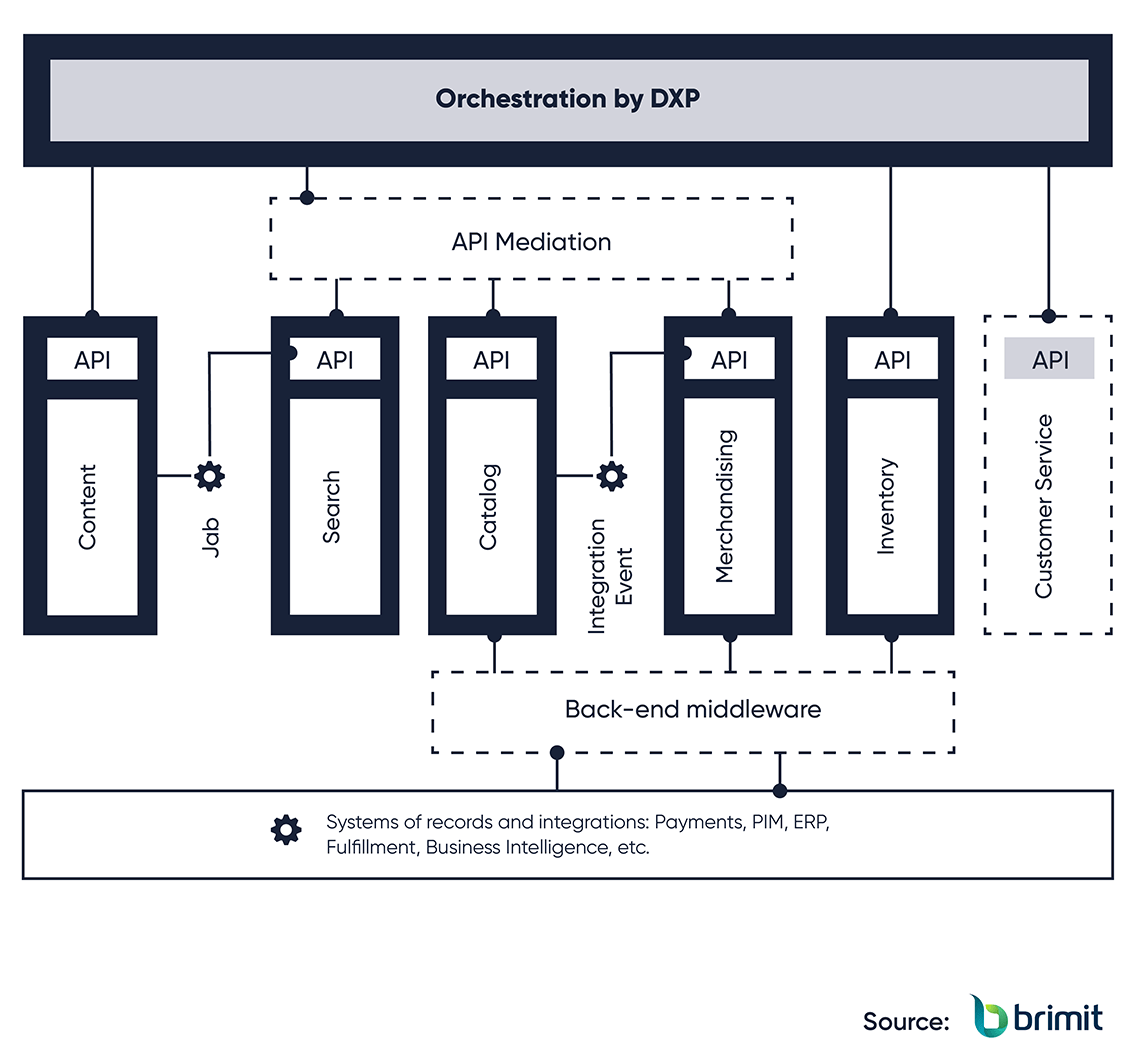
Image 3.
How a composable DXP embodies the MACH principles, Brimit©
A Composable DXP Has Been Used Successfully on Several Projects
How Sitecore DXP and Sitecore OrderCloud Work Together
- OrderCloud—for integrations with digital and offline points of sale, back-end systems, and BI tools
- Sitecore XM Cloud—for content management capabilities, multichannel publishing, organizing the presentation layer, and experience management
- Sitecore Send—for segmented and personalized campaigns, commerce integrations, and automation
- Sitecore CDP—to consolidate real-time and historical customer data in a single view
- Sitecore Personalize—to predict the next best action for customers based on real-time behavior and business context
- Sitecore Discover—to identify customer intent in real time and display the most relevant search results and product recommendations
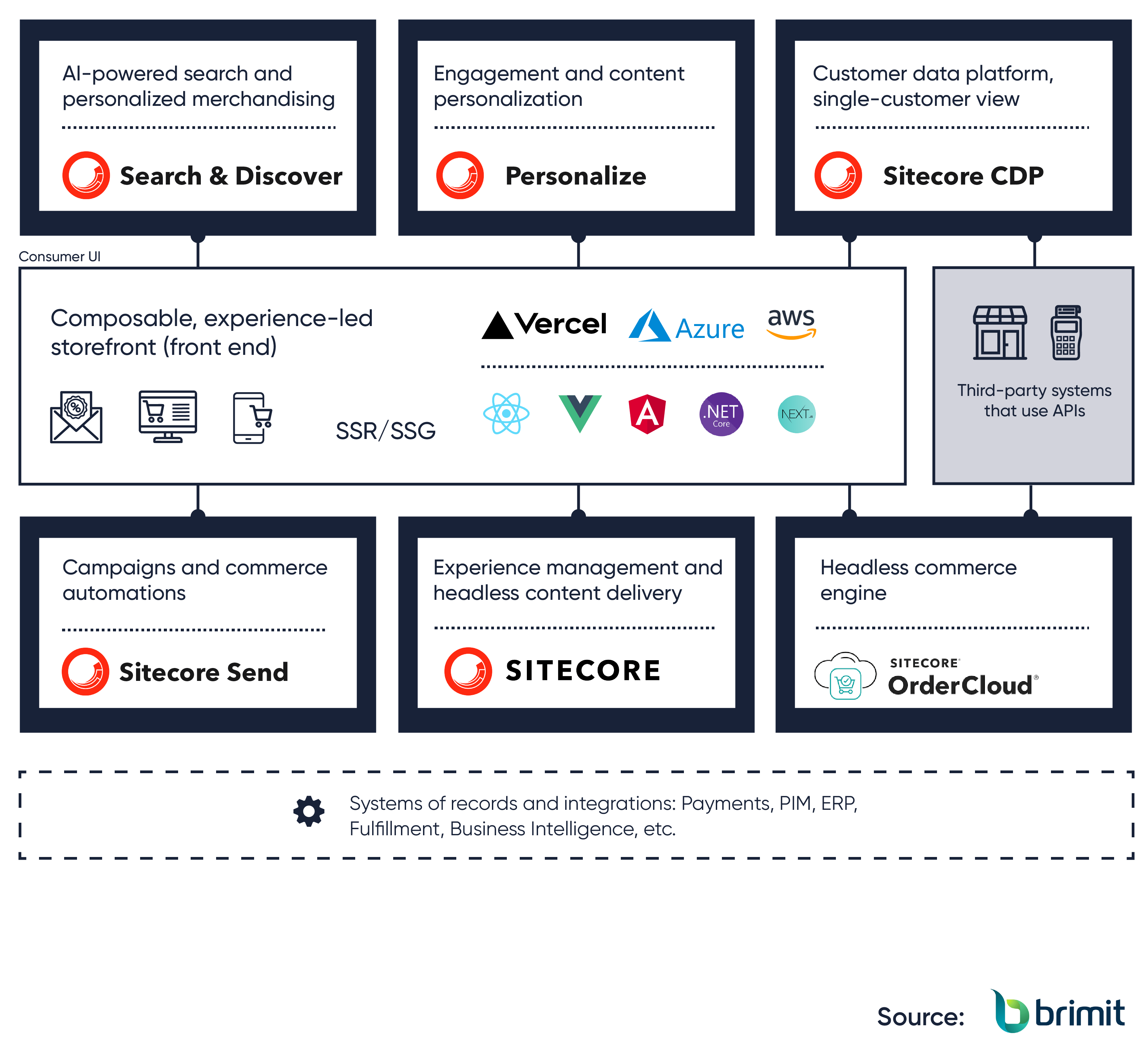
Image 4.
Bringing together Sitecore DXP and Sitecore OrderCloud, Brimit©
Why Sitecore OrderCloud Is the Right Fit for IT
- Developer-friendly. OrderCloud is language-agnostic and provides access to particular domains through the OpenAPI specification. In addition, developers can use their preferred tech stack. OrderCloud also provides an online developer portal for testing and interacting with the APIs.
- Getting started is fast. Get a live storefront in five minutes on Vercel. Both are free and fast.
- Platform Extensibility. OrderCloud supports various options, including jobs, webhooks, middleware proxies, and integration events.
Why Sitecore OrderCloud Is the Right Fit for Business
OrderCloud’s robust model can support even the most complex organizations.
Instead of being limited by a basic e-commerce platform with only one catalog and a single definition of a user, OrderCloud has several building blocks, which you can combine however you want to represent your organizational structure.

Image 5.
OrderCloud Building Blocks, OrderCloud.io©
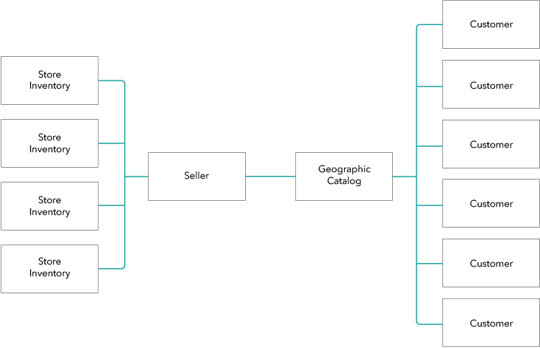
Image 6.
B2C Experience with OrderCloud, OrderCloud.io©
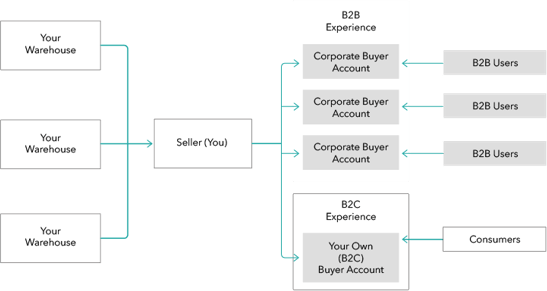
Image 7.
B2B Experience with OrderCloud, OrderCloud.io©
Today’s markets change fast, which means e-commerce platforms need to be able to adapt quickly. When organizations choose the commerce-led approach to e-commerce architecture, they opt for strong core features that have more technical limitations. On the other hand, with the experience-led approach, it is much easier to make changes when necessary.
Make sure your commerce platform is flexible enough to meet the challenges of fast-evolving markets: Contact us for a demo of an experience-led e-commerce platform.
1. Gartner “Adopt a Composable DXP Strategy to Future-Proof Your Tech Stack” by Irina Guseva, Yefim Natis published 16 December 2020
2. Gartner, Predicts 2022: Customer Service and Support — Paving the Way for Greater Ambition and Responsibility for the Customer Experience, Jim Davies, David Norrie, Pri Rathnayake, Steve Blood, 19 November 2021
GARTNER is a registered trademark and service mark of Gartner, Inc. and/or its affiliates in the U.S. and internationally and is used herein with permission. All rights reserved.
